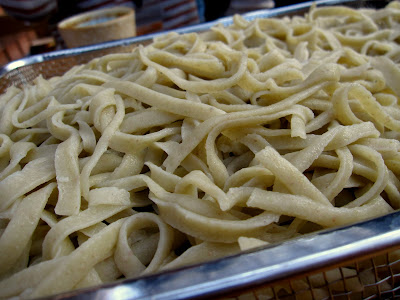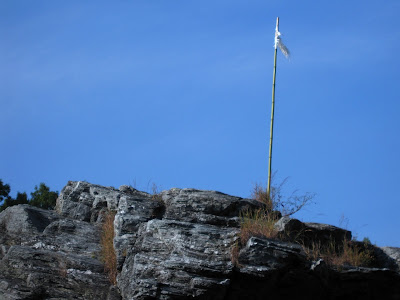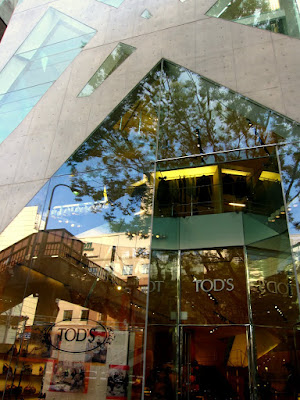The university is constantly organising various outings and events for all the exchange students, which I think is a fabulous idea. In fact, I am very happy with the support that Waseda is giving us - there's always something to do!
One such event was a day trip to Chichibu, right in the mountains of Saitama prefecture, about an hour and a half by bus northwest of Tokyo.
View Larger Map
I signed up at the last minute, wanting to see a part of Japan *outside* of Tokyo, and was lucky enough to be picked as one of the forty-or-so students to attend.
We set off early in the morning (8am... not good) and took a bus directly from the university itself, and it wasn't all that long before we reached our destination- a rather large farm which grew, somewhat peculiarly, grapes. I was very confused and surprised when I first noticed this, because I was unaware that grapes were even grown in Japan! The way the grapes were grown, too, intrigued me...
For whatever reason, the individual bunches were wrapped in perforated plastic bags - rather odd, I thought. I was told it has something to do with the humid climate they are grown in, but I think it might also be due to the peculiar Japanese custom of wrapping everything. Seriously, in a supermarket the peaches are individually wrapped in foam and they give you a bag for everything! Even in a 100-yen shop, the staff lady took care to individually wrap my 100-yen glasses (for reference, 100 yen is about $1.30). I know this is side-tracking a little, but those 100 yen glasses were actually decent! Made in Japan (not made in China? What is this?) and certainly superior to anything you could buy for a similar price back home.
Anyway, where was I... oh yes, soba making! Once at the farm we were divided into groups and given the task of creating soba from scratch! I should briefly explain what soba is - it's a type of noodle made from buckwheat flour and shaped much like spaghetti, except somewhat more square (look at the picture above for a non-perfect example -_-;; ). It can be eaten either hot or cold, and is traditionally served plain (as above) with a bowl of broth on the side which you dip the noodles in before eating.
We were given a little help while making the soba, but no matter how hard we tried, my groups' still ended up looking like they were cut by a child with a pair of toy scissors. Still, they were edible, and we enjoyed a lunch of our own hand-made soba!
While it was incredibly tasty, I thought the meal was somewhat lacking. While wholesome buckwheat soba, a light soy broth and a few slices of spring onion may be the stuff that sustains remote mountain hermits to live for decades, I, a growing (I can hope) young man, needed something a little more meaty and as such spent the rest of the day hungry. Luckily there were plenty of things to distract myself with!
After lunch we had some time to walk up the hill behind the farm and admire the views and rest in the hammocks:
Our day did not end with soba-making, though. After an hour of free time, we boarded the bus again and headed to a nearby river. Here, were were treated to the experience of riding on a boat down a river with scenery that had made the place a 'national beauty spot'! Needless to say, it was a magical experience - and oh so different from the neon lights of Shinjuku and Shibuya. There were waterfalls, rapids, 100-year-old railway bridges (still in use!) and even what looked like filming for a TV drama. Fantastic!
What made the trip interesting in another way was that the area is also known as the 'birthplace of Japanese geology', presumably for the impressive rocks to be found there. Much to the horror of one of my Japanese friends, I took a small piece of this rock with me, and it's now sitting on my desk.
I also returned to Saitama on the weekend, but that is a tale for another blog post... (unless something more interesting occurs in the meantime!)
return to blog home
Labels: exchange japan, saitama, waseda
It's a Friday night, you've just had a delicious bowl of tonkotsu ramen at Ippudo, and the night is still young. What do you do?
Walk among the side-streets of course!
Although I am in Shinjuku ward, and hence the centre of Tokyo, the wonderful thing about the area that I live in (and much to Tokyo) is that the streets have retained their tiny, narrow, winding quality from ages past. Even when the city was fire-bombed in the final stages of WWII (remember the houses were pretty much all wood and paper back then), they rebuilt it in almost exactly the same way.
What this means is that it is very easy to have a night of adventure simply by getting lost among the alleyways.
I could go into so much detail about what I saw, but I shall keep it brief so as not to overload you all:
- A tiny, crazy-looking Mazda sportscar with gullwing doors. Saw the owner and had a small chat with him too - he was also a student at Waseda! Dave took a photo with his phone, but I do not have it...
- Numerous interesting looking bars and restaurants. More often than not these were absolutely tiny, seating no more than 5 or 6 people, but looked like perfect places to go on a quiet night out (or date, I suppose...;) )
- The Tokyo Academy of Bread, offering two year bachelor degrees in bread and cake making.
- A huge, apparently Edo-era mansion. I have no idea how we can just stumble across these things in the middle of Tokyo, where the land price is so high.
- Lots of little parks.
- Cats!
Also, earlier today I came across an ex-rental CD sale right near the station. The CDs were in very good condition, and at such great prices that I couldn't help myself when I found two of Monkey Majik's earlier albums....
Unfortunately, and to cut a long story short, I missed the typhoon experience. It struck Tokyo at around 2:30am on Thursday morning, and while I was told it made quite the racket, I must have slept soundly through it. When I woke up, in fact, it was a beautiful day with nary a cloud to be seen.
Something must have happened, though, because the other news I awoke to was that the entire day's class had been cancelled. "Excellent", I thought to myself, "Now I can go and see another part of Tokyo...".
We (Dave, Anthony and I) decided to go to Asakusa, because it was part of 'downtown' Tokyo that I was yet to see (where I live, Shinjuku, is part of the 'up-town'). It wasn't too long of a train and subway ride before we arrived at our destination, Asakusa.
Asakusa is known firstly and foremostly for it's temple, Senso-ji, which has been in the same position more or less since the seventh century AD. Coming to Asakusa for the first time, it was a must-see for us:
When I was in Harajuku last week, I caught a glimpse of a poster advertising the Mille Miglia Japan, which was to be kicked off at Harajuku on the 13th of October. I thought there was only one Mille Miglia in the world?
Apparently, Japan begs to differ, and with sponsors ranging from Alfa Romeo to Alitalia (how do they have money to sponsor things?), this event was every inch the real deal.
I wandered over to Harajuku with my friend Tatsuki (he was the guy who bought a DSi along with Dave and I). Fortunately for us, the event was very easy to find, as it was located at the entrance to the Meiji-jingu shrine, right next to the train station. It was about 10:30 at the time, and the event did not kick off until 12, so we spent the in-between time holding ourselves a prime viewing position right next to the fence and taking some photos of the cars lined up at the gateway.
I took many photos on the day, but most of them were rubbish, so I have selected only a couple to show you here on the blog:
I spent some time at the Kinoshita's house, eating the delicious food they had prepared for me, and the time passed very quickly (no doubt aided by the Asahi and sake they kept pouring). It was soon dinner time, and to my surprise I was invited to go along with the Kinoshita's for dinner at a local Jazz bar.
On the way, we stopped at a pachinko parlour because I mentioned that I had never played pachinko before. After this brief experience, I can safely say that I do not want to play again. To explain it briefly, pachinko is like pokies, except a whole lot more pointless. You pay money for a certain amount of ball bearings, which you then insert in a machine and hope they come out again. I had no idea how the people sitting next to me managed to accumulate whole piles of the things while mine dissappeared in seconds - and nor did I really want to dwell on it. Those ball-bearings could not really be exchanged for anything of worth (like, say, money), and I left the parlour at a loss as to why people would waste their money, time and eardrums (it was incredibly noisy inside) on pachinko when they could instead play something like DDR ;)
Dinner was delicious yakitori skewers accompanied by an American blues band. I could describe it all, but instead I will leave you with this video - definitely a day I will not forget!
PS: If any of you would like to have a different take on the Waseda/Japan experience, Alicia has a great blog and even better photography - something for this blog to aspire to, I suppose :P
"We're in the middle of a financial crisis", they say. "Japan's economy has been stagnating since the late 1980s", they say. "China is where all the money is these days", they say.
Well, the very important thing that these hypothetical people are forgetting is that Japan is still very much the second largest economy in the world. To put that in other words - there is a LOT of money floating around here, and nowhere have I noticed it more so far than my trip to Harajuku and the Omotesando on Sunday.
Ever since I'd stumbled across Toyo Ito's work on the Tod's Omotesando building in my Year 12 design class I have wanted to go to visit it. The glass and concrete building, built to resemble the trees on the street in which it resides, was a great inspiration to me in my work.
When I woke up on Sunday to find it a mild, sunny, day, I knew that I could not waste it by staying in my room and doing homework. So, after a quick lunch at Yoshinoya (fairly cheap chain restaurant, which I think tastes pretty good), I took the Yamanote line to Harajuku. (For those of you that don't know, the Yamanote line is a circular train route that goes around various parts of central Tokyo. Well, to be specific, it goes around the uptown areas - the word literally means 'hands of the mountains')
Harajuku itself is a very interesting place. To foreigners, it is the home of the famed 'Harajuku Girls' (google it and you'll see what I mean), and to the Japanese, it's a place for cheap (girls) clothes and sweet crepes (yeah, I don't know... check out the photo below). In fact, it seems like an area catered to girls in general - there were numerous shops selling male idol merchandise. I ventured into one in search of Tohoshinki goods and was rewarded by a Jaejoong keychain from a 200yen vending machine. As I was the only guy in the shop, though, I did feel sort of weird...
After I had walked down the main Takeshita-dori pedestrian street, I turned to the Omotesando - where the real shopping happens. If there is a well-known fashion brand that you like, chances are they have a store here. Prada, Bulgari, Lois Vuitton, Ralph Loren - to name but a few - all have amazing buildings here. The level of self-presentation of the people walking on the street was very high (as it is in most places I've been so far in Japan), apart from the tourists (of which there were many), and on the street itself many, many, many nice and incredibly expensive cars could be seen.
To give you an example, this man in, oh, you know, a red F430 Scuderia (looked and sounded SO NICE) just pulled over in the middle of the road while his wife stepped into the Louis Vuitton shop.
This Diablo broke down (?)
To be honest, not all people were allowed to flout the law so. I did see a silver SLR McLaren Mercedes recieving a parking ticket sometime later.
Not all of the cars were what one would call 'luxury', but they were certainly interesting:
I was out to find the Tod's store, but before I set off, I quickly watched the first lap of the Japanese GP on my phone. How convenient. While sitting down, I saw my first 'Harajuku Girls', who were, strangely, not Japanese:
I ended up walking up and down the street several times before finding it, including a rest stop at a cafe that served Lavazza coffee. The cappucino and muffin I had cost me more than my lunch (about $8 all up), but was worth it for the chance to have Italian coffee and to sit down a while.
Here are some of the buildings that I saw along the way, including, at last, the Tod's building:
In the end, I think my favourite was the Prada building (first photo there). Very cool.
Anyway, afterwards I decided to walk along to Shibuya in search of the massive intersection that you see in so many movies. Along the way, I even saw what appeared to be an Australian fashion building!
It goes without saying that I was distracted on my way to Shibuya station and my way home. In one CD shop, they had a very large section dedicated to Tohoshinki. They had everything - all the CDs, the singles, the DVDs and the photobooks. I had to walk out of there in a hurry lest I bought something - the keyring would have to satisfy me for now.
The big intersection wasn't all that hard to find in the end - it was right by the entrance to the station!
One day, I will return to the Omotesando to shop! *adds to self-goals list*
PS: I said I would write shorter posts, didn't I? Sorry...
Hrm, well, I guess the game *is* completely in Japanese, so in actual fact what I have bought is merely another learning tool! That's what I shall tell myself in those restless times at night when I am filled with regret and self-doubt. Indeed....
Why are there three DSis? Well, today, I went with my friends Dave (also Aussie), Mike (from Arizona) and Tatsuki (Japanese guy - very awesome) and three of us bought a DS and that particular game, Dragon Quest IX. Mine is the red one~ although I think the metallic blue colour is also very cool. Now, to start learning, slowly, how to play...



































